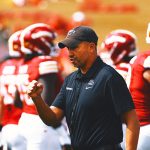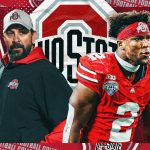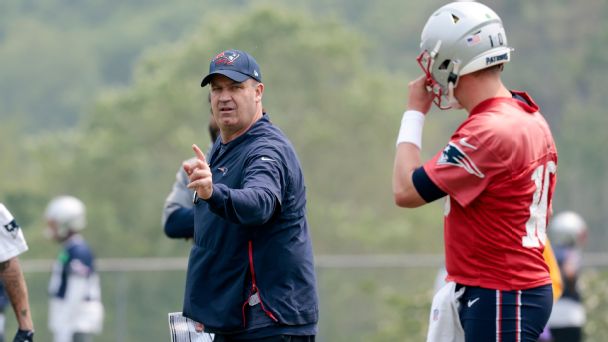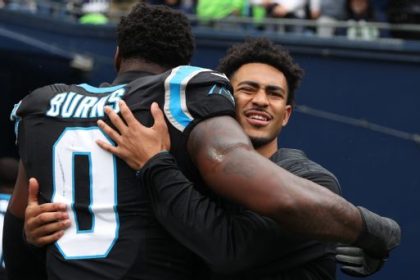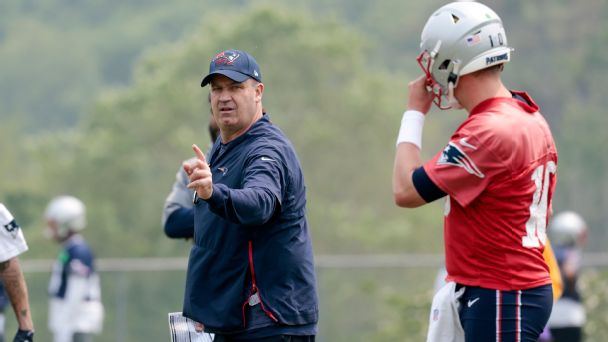
FOXBOROUGH, Mass. — New England Patriots owner Robert Kraft had a vision that came to fruition during the spring. If his calculation is correct, the decision to bring back Bill O’Brien as offensive coordinator will rank among the NFL’s most impactful offseason moves.
The return of O’Brien, the Patriots’ OC from 2009 to 2011, is among the top reasons Kraft is hopeful that last season’s 8-9 record — lowlighted by a Mac Jones-led offense that plummeted to the bottom of NFL rankings in several key categories — was more of a one-off than a sign of sub.-500 things to come.
And the primary beneficiary should be the starting quarterback.
“We experimented with some things last year that frankly didn’t work when it came to [Jones],” Kraft said in March. “We made changes [this offseason] that I think put him in a good position to excel. I think bringing in Bill O’Brien will work to his advantage.”
Of all the words spoken by Patriots executives, coaches and players this offseason, arguably nothing was more direct — and important — than that statement.
Kraft, coach Bill Belichick, Jones and the Patriots want to put last season’s offensive slog behind them, and the first step in doing so was to acknowledge that Belichick’s 2022 plan didn’t work.
Jones and O’Brien had crossed paths briefly when the quarterback was entering the 2021 draft and O’Brien had been hired as offensive coordinator at Alabama, Jones’ alma mater. They talked about generalities of Alabama’s offense at that time.
But one thing O’Brien has made clear since his return to New England: He isn’t interested in looking back — whether it’s that brief time he had with Jones, his high-profile history with the Patriots, his time as a college and NFL head coach or what happened to the 2022 New England offense he was brought in to fix.
“It’s not about anything that’s gone on in the past,” he said. “That’s one of our themes on offense — to move forward.”
WHAT WILL THE Patriots’ offense look like?
When O’Brien first met with Patriots reporters in April, he said bluntly: “It would be crazy for me to stand up here and tell you what we’re doing offensively.”
But he also acknowledged: “There’s a framework. You go back and look at the experiences you’ve had at different places and different experiences some of the guys on staff have had, and you develop that framework.”
O’Brien has a decade’s worth of invaluable experience — head coach for Penn State (2012-13) and the Houston Texans (2014-20), OC at Alabama (2021-22) — to pair with his prior stint as Patriots OC.
Combining that with new offensive line coach Adrian Klemm and his background with protection calls and rules — from his Patriots playing days (2000-04) and his coaching career with SMU, UCLA, the Pittsburgh Steelers and Oregon — provides the foundation for the Patriots’ attack.
If spring practices are any indication, playing fast will be a notable part of the approach, as O’Brien regularly implored players to pick up their pace. And history says to expect a lot of empty formations, where there is no running back in the backfield.
When O’Brien was Texans coach from 2014 to 2020, his offense was in an empty formation 767 times (10.5% of their plays), according to ESPN Stats & Information. Only the Cardinals (916) and Steelers (856) ran more total plays in empty formations over that span.
That would be a big change for Jones.
The Patriots ran 47 plays in empty formations last season, fourth fewest in the NFL. In 2021, when the rookie Jones might have been protected in his transition to the NFL by former Patriots OC Josh McDaniels, the Patriots ran 44 plays in empty formations (second fewest).
Greg Cosell, who has studied Jones and the Patriots’ offense in his work for ESPN’s “NFL Matchup” show, says Jones could thrive.
“Empty formations allow the quarterback to see what the defense is doing pre-snap,” Cosell said on the “Inside the Birds” podcast. “Mac Jones needs to be a high-level pre-snap quarterback. He needs to research and understand what the defensive look is before the snap of the football, and then he can execute. He is an executor and ball distributor. So you give him every tool in the toolbox so he can do that prior to the snap of the ball.”
After a full spring operating O’Brien’s offense, Jones echoed Cosell’s thoughts.
“It’s all about your toolbox, and that’s what is so great about the system,” he said. “As a quarterback, the most is put on you, but that’s a good thing because you have tools to fix it.”
AJ McCarron, who was a backup quarterback for O’Brien with the Texans in 2019 and 2020, refers to O’Brien’s system as “quarterback friendly.”
“Going to Houston helped me grow as a player, because it was all about the quarterback getting the offense in the best situation possible,” he said. “OB is a very intelligent coach. He gets guys to play hard.”
In addition to Jones, other Patriots seemed encouraged throughout the spring.
“Change is good,” receiver Kendrick Bourne said. “It’s something we needed.”
“OB has a great system,” said tight end Mike Gesicki, who signed as a free agent in March after five seasons with the Miami Dolphins. He’s reuniting with O’Brien, who recruited him to Penn State before departing to become the Texans’ coach. “It’s exciting to get in the meeting rooms and see how it’s run.”
O’BRIEN DOESN’T WANT anyone looking back to 2022, which is understandable. Still, it’s hard to deny there isn’t some residual scar tissue for those who endured it, particularly Jones. How that is managed will be critical moving forward. So what went wrong last season?
Belichick, who has earned latitude to make unconventional decisions because of his legendary success, saw an opportunity to reshape the offense after McDaniels left in 2022 to become the Raiders coach after 10 seasons as Patriots offensive coordinator. Belichick tapped longtime defensive coach Matt Patricia to carry out his vision and longtime special teams coach Joe Judge as quarterbacks coach.
When it comes to thinking outside the box, it might have been No. 1 in the all-time Belichick power rankings.
As Kraft had explained while it was unfolding: “I think Bill has a unique way of doing things. It’s worked out pretty well up to now. It doesn’t sometimes look straight-line to our fans or myself, but I’m results-oriented.”
The results were unfortunate for all involved. Belichick’s plan, which included revamping the offensive linemen’s rules and calls, led to the Patriots finishing last in the NFL in red zone efficiency (19 TDs in 45 trips) after they were 11th the season before (39 TDs, 63 trips).
Belichick has long cited the red zone as one key barometer of offensive success. Third-down efficiency is another he often mentions as critical, and the Patriots finished 27th at 34.8%, a notable drop from their No. 10 ranking the season before.
And, of course, points scored is where Belichick usually starts when identifying key statistics. The Patriots, with Jones regressing from a promising 2021 rookie season, totaled 31 offensive touchdowns in 2022, down from 48 the season before.
All of which led the organization back to O’Brien, whose presence and command were eye-opening and ear-grabbing during spring practices. Some of the more familiar protection rules and calls for offensive linemen have returned, and Jones — whose frustrations got the best of him at times in 2022 — looked more decisive and at ease.
“It’s been normal. I think everything he’s done so far has been really good,” Jones said in May. “I think the communication is the most important part, and trust. He’s done a great job controlling the room. I feel like everyone’s on the same page.”
THE PATRIOTS MUST decide whether to pick up Jones’ fifth-year option for 2025 by May. The option is projected to be in the $25 million range, a significant payday, which highlights why this is a critical season for Jones (2022 base salary of $2.076 million) to bounce back and for the Patriots to ascertain a more accurate assessment of what they have in the 2021 No. 15 overall pick.
Jones has said there’s “good juice” within the team facility, where he spent most of the offseason impressing O’Brien with a relentless work ethic.
“I feel like we’ve all put in some really good work. We’ve learned a lot about ourselves, but it doesn’t tell until you put the pads on,” he said.
Jones and O’Brien have also learned more about each other.
“He’s been around and taken a lot of good things from each stop. For me, it’s just being a sponge,” Jones said. “Whatever quarterback he’s coached, I can learn from, whether that’s Bryce [Young] or Deshaun [Watson], or at Penn State. He has such great experience in this league and in the football world, it’s like a walking dictionary.
“So just pick his brain and see the game how he sees it, and then come together and mesh to create a really good offense.”
Jones said there are concepts and terminology within O’Brien’s offense he has experienced before.
For O’Brien, a native of Dorchester, Massachusetts, a return home has also been energizing after two years at Alabama. His son, Michael, is enrolling at Tufts University (Medford, Massachusetts) in the fall after being recruited to play baseball.
Returning to the NFL has also created a spark for him.
“I love both, I really do. I’m kind of 50-50 [in my career] — approximately half in college, half in NFL,” O’Brien said.
“I enjoy being in the NFL and being around the professionalism of this organization, these players, this coaching staff. The process of the NFL is always something I’ve enjoyed.”

